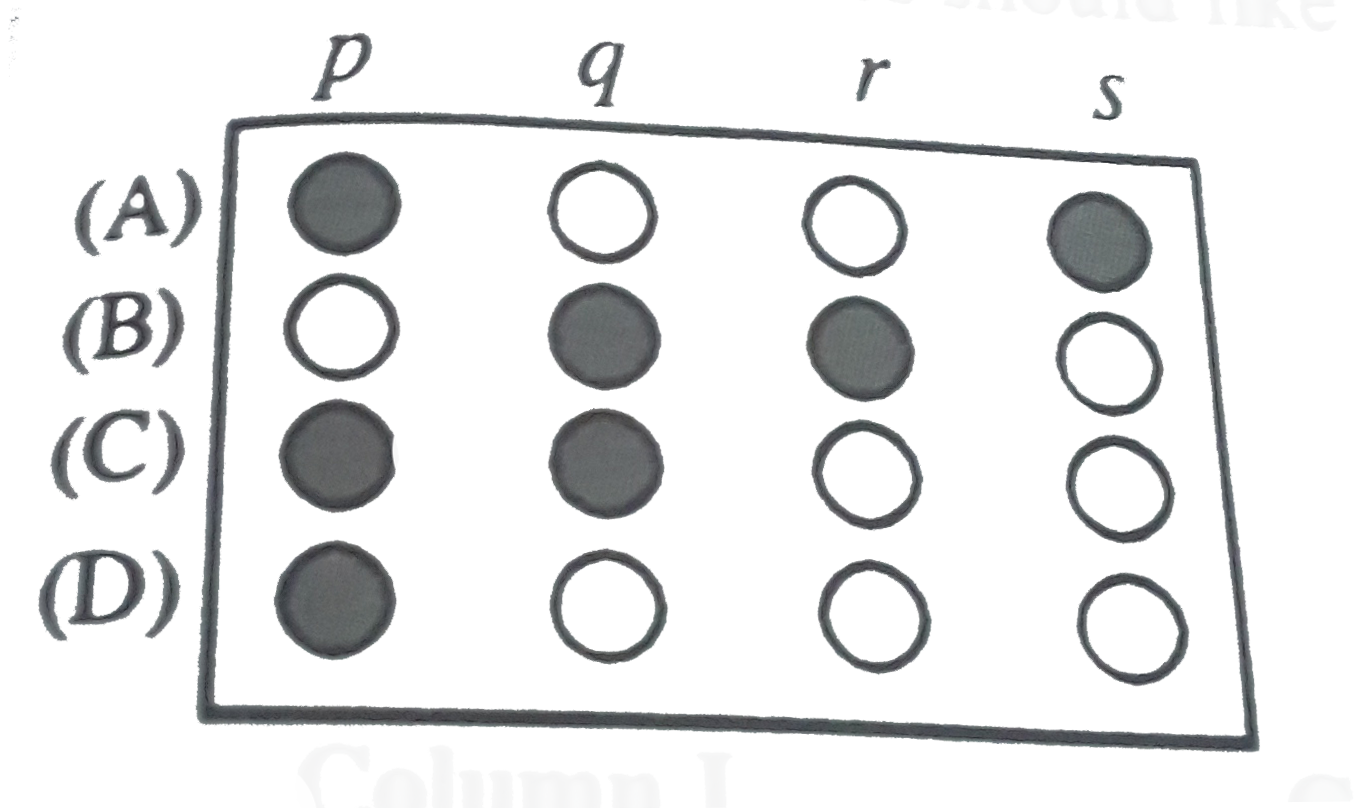Column IColumn II(A)B2H6(p)Borax(B)BF3(q)Lewis acid(C)AlCl3(r)pπ−pπ back bonding (D)H3BO3(s)NaBH4
The correct Answer is:(A-s; B-q,r; C-q ; D-p,q)
To solve the matching question between Column I and Column II, we will analyze each compound in Column I and identify its corresponding property or classification in Column II.
1. Identify A: B₂H₆
- B₂H₆, also known as diborane, is a compound of boron and hydrogen. It is often associated with the formation of borax (Na₂B₄O₇·10H₂O) in various chemical reactions.
- Match: A → S (Borax)
2. Identify B: BF₃
- BF₃ (Boron trifluoride) is a well-known Lewis acid. It can accept an electron pair due to the empty p-orbital of boron, which allows it to act as an electron pair acceptor.
- Match: B → Q (Lewis acid)
3. Identify C: AlCl₃
- AlCl₃ (Aluminum chloride) is also a Lewis acid. It has an empty d-orbital that allows it to accept electrons easily, making it a strong Lewis acid.
- Match: C → Q (Lewis acid)
4. Identify D: H₃BO₃
- H₃BO₃ (Boric acid) is often referred to as boric acid and is commonly associated with the term "borax" in certain contexts. However, in this case, it is more appropriate to classify it as a compound that exhibits pπ-pπ back bonding due to the presence of p-orbitals in boron and oxygen.
- Match: D → P (pπ-pπ back bonding)
Final Matches:
- A → S (Borax)
- B → R (Lewis acid)
- C → Q (Lewis acid)
- D → P (pπ-pπ back bonding)
- B₂H₆, also known as diborane, is a compound of boron and hydrogen. It is often associated with the formation of borax (Na₂B₄O₇·10H₂O) in various chemical reactions.
- Match: A → S (Borax)
- BF₃ (Boron trifluoride) is a well-known Lewis acid. It can accept an electron pair due to the empty p-orbital of boron, which allows it to act as an electron pair acceptor.
- Match: B → Q (Lewis acid)
- AlCl₃ (Aluminum chloride) is also a Lewis acid. It has an empty d-orbital that allows it to accept electrons easily, making it a strong Lewis acid.
- Match: C → Q (Lewis acid)
- H₃BO₃ (Boric acid) is often referred to as boric acid and is commonly associated with the term "borax" in certain contexts. However, in this case, it is more appropriate to classify it as a compound that exhibits pπ-pπ back bonding due to the presence of p-orbitals in boron and oxygen.
- Match: D → P (pπ-pπ back bonding)
- A → S (Borax)
- B → R (Lewis acid)
- C → Q (Lewis acid)
- D → P (pπ-pπ back bonding)
Topper's Solved these Questions
- SOME p-BLOCK ELEMENTSBOOK - PRADEEPCHAPTER - SOME p-BLOCK ELEMENTSEXERCISE - Competition Focus (JEE( Main and Advanced)/Medical Entrance) VI. Integer Type Questions
6 Videos
- SOME p-BLOCK ELEMENTSBOOK - PRADEEPCHAPTER - SOME p-BLOCK ELEMENTSEXERCISE - Competition Focus (JEE( Main and Advanced)/Medical Entrance) VII. Numerical Value Type Questions
1 Videos
- SOME p-BLOCK ELEMENTSBOOK - PRADEEPCHAPTER - SOME p-BLOCK ELEMENTSEXERCISE - Competition Focus (JEE( Main and Advanced)/Medical Entrance) IV. Matching Type Questions
3 Videos
- SOLID STATE BOOK - PRADEEPCHAPTER - SOLID STATE EXERCISE - Advanced problems
19 Videos
- STATES OF MATTER : GASES AND LIQUIDESBOOK - PRADEEPCHAPTER - STATES OF MATTER : GASES AND LIQUIDESEXERCISE - VIII. ASSERTION-REASON TYPE QUESTIONS (TYPE-II)
12 Videos
Similar Questions
Match the entries of column I with appropriate entries of coloumn II. Each entry in column I may have one or more than one correct option from column II. If the correct matches are A-p, s , B-r, C-p, q , D-s, then the correctly bubbled 4 × 4 matrix should be as follows :
Column IColumn II(A)SO2(p)Basic(B)H2SO4(q)Acidic(C)HNO3(r)Reducing(D)NH3(s)Oxidising
View SolutionHere each question contains statements given in two column which have to be matched. Statements in columns I are labelled as A, B, C and D where as the statements in column II are labelled p, q, r and s. The answers to these questions are to be appropriately bubbled as illustrated in the following example.
If the correct matches should like the following.

Column IColumn II(A)SO2(p)Basic(B)H2SO4(q)Acidic(C)HNO3(r)Reducing(D)NH3(s)Oxidizing
View Solution
Knowledge Check
Match Column I with Column II and select the correct option.
Column IColumn IIA.BeH21.ComplexB.AsH32.Lewis acidC.B2H63.InterstitialD.LaH34.CovalentE.LiAlH45.Intemediate6.IonicAA−6,B−2,C−4,D−5,E−1BA−6,B−2,C−4,D−3,E−1CA−6,B−4,C−2,D−3,E−1DA−5,B−4,C−2,D−3,E−1Match the entries of column I with appropriate entries of coloumn II and choose the correct option out of the four options (a), (b), (c) and (d) given at the end of each question.
Column IColumn II(A)PCl5(p)Angular(B)IF7(q)Pyramidal(C)H3O+(r)Trigonal bipyramidal(D)ClO2(s)Pentagonal bipyramidalAA−r,B−s,C−q,D−pBA−r,B−q,C−p,D−sCA−p,B−s,C−q,D−rDA−s,B−p,C−r,D−q
Here each question contains statements given in two column which have to be matched. Statements in columns I are labelled as A, B, C and D where as the statements in column II are labelled p, q, r and s. The answers to these questions are to be appropriately bubbled as illustrated in the following example.
If the correct matches should like the following.

Column IColumn II(A)NH3(p)Basic(B)PH3(q)sp3 hybridized(C)H2S(r)Acidic(D)H2O(s)Hydrogen bonded
View SolutionMatch the following :
Column IColumn II(a)CH6H5CHO(p)Haloform reaction(b)HCHO(q)Fehling's solution(c)CH3CHO(r)Cannizzaro reaction(d)CH3−CO−CH3(s)Knoevenagel reaction
View SolutionMatch the statements (A, B, C, D) in Column I with the statements (p, q, r, s) in Column II. Answers to the questions have to be properly bubbled.
∣∣ ∣ ∣ ∣ ∣ ∣∣Column IColumn II(A)CH3CH(OH)CHO(p)Carbohydrate(B)HOCH2CH(OH)CHO(q)Amino acid(C)CH3CH(NH2)COOH(r)Positive Tollen's test(D)C6H5CH(CH2NH2)COOH(s)Ninhydrin test∣∣ ∣ ∣ ∣ ∣ ∣∣

View SolutionHere each question contains statements given in two column which have to be matched. Statements in columns I are labelled as A, B, C and D where as the statements in column II are labelled p, q, r and s. The answers to these questions are to be appropriately bubbled as illustrated in the following example.
If the correct matches should like the following.

Column IColumn II(A)H3PO3(p) more basic(B)H3PO3(q) reducing(C)H2SO3(r) dibasic(D)H3po4(S) reducing
View SolutionMatch Column-I with Column-II
Column-IColumn-II(A)XeF2(p)Square pyramidal(B)PCl5(q)linear shape(C)XeOF4(r)sp3dhybridization(D)XeF4(s)sp3d2
View SolutionColumn-IColumn-II(A)BBr3+H2→B(p)Borax bead test(B)Na2B4O7.10H2O+CuSO4→Cu(BO2)2(q)Reduction(c)AlCl3+H2→HCL(r)White fumes(D)Cr2O3+Al→Cr(s)hydrolysis
View Solution
